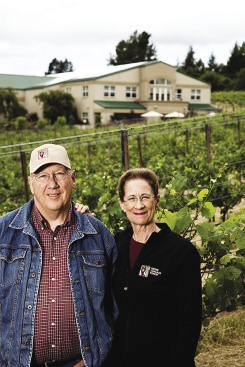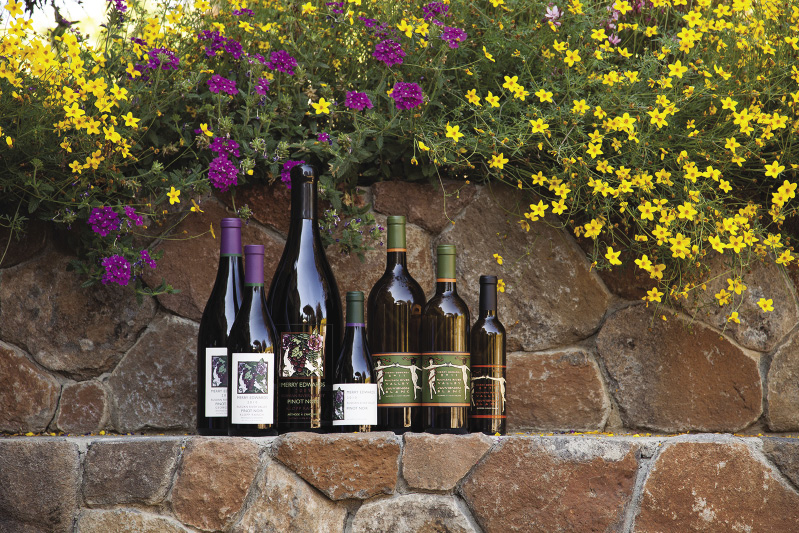


![]()
ONLINE

Ken Coopersmith and Merry Edwards
in front of their winery
Consistent Quality
Editors’ Note
As one of California’s first female winemakers, Merry Edwards began her career in 1974. After making wine at Mount Eden Vineyards, Matanzas Creek, and a host of other wineries, in 1997, family and friends joined Merry to found Merry Edwards Winery. She and her husband, Ken Coopersmith, now manage five estate vineyards. Two regional blends and six vineyard designates are bottled. In 2001, a barrel-fermented Sauvignon Blanc blend was added to the portfolio and has been lauded as the best Sauvignon Blanc being made in the United States. She has been called the Queen of Pinot Noir and Sauvignon Blanc, and her wines have graced many Top 100 lists. Merry and Ken completed their new state-of-the-art winery facility in 2008 on the site of Coopersmith Vineyard. In this new venue, tastings are hosted to educate visitors about Merry’s handcrafted wines and site-specific viticulture. In 2013, Merry was inducted into the Vintners Hall of Fame and, in addition, won the prestigious James Beard Foundation award for Best Wine or Spirits Professional.
Company Brief
In 1997, Merry Edwards co-founded a business venture, allowing her to produce Merry Edwards Wines (www.merryedwards.com) from select pinot noir grapes in the Russian River Valley and Sonoma Coast, including her own vineyards: Meredith Estate, Coopersmith, Cresta d’Oro, Georganne, and Flax Vineyard. The family of vineyard designate wines now includes Klopp Ranch and Olivet Lane. Edwards began making a Russian River Valley sauvignon blanc under her label in 2001.
What made you decide that the time was right to create your own facility?
I never intended to do a brick-and-mortar winery facility; I wanted to integrate within another winery.
But as the wine industry became more profitable before 2008, this space started drying up, and rates for custom production skyrocketed. Our production grew beyond where I imagined it would. We started off with 2,200 cases and kept bumping it up every year.
At some point, you tip over into where it becomes financially prudent to look at your own facility.
So we broke ground in 2006, opened the facility in 2008, and in 2010, we started expanding it because we hadn’t anticipated how successful our new tasting venue would be.
Meanwhile, we leased more property to control our vineyards, especially the Pinot Noir. Recently we purchased another piece of property that will give us 15 acres of Sauvignon Blanc. We’re preparing to plant three vineyards in 2015.
We went from something we visualized being virtual to now owning our own facility and, by 2015, we’ll have almost all of our own grape sourcing. We have a beautiful winery facility that has helped our success because of our tasting venue.

Merry Edwards wines
Are there challenges that come with that kind of growth?
The only way we can be successful is to have control. This control has come by progressively replacing purchased fruit with our own grown fruit, through vineyards we leased that are existing or planting new vineyards on leased land or purchased land, and having our own facility gives us this incredible control over the process.
Will you continue to broaden or will the Pinot Noir remain the main focus?
We were making 90 percent Pinot years ago and 10 percent Sauvignon Blanc, and now it’s almost 50/50.
This change came about because of the success of our Sauvignon Blanc program, which created its own whirlwind and vortex of success. We started making it but we weren’t looking at it being a serious part of our production. But it was so popular, even though it was expensive – there is nothing else like it in America.
So because it’s a less capital-intensive wine to make, it was a very good thing for us during the downturn when people were cutting back on purchasing high-end Pinot Noirs. We were able to supplement our production with more Sauvignon Blanc and create a healthier balance.
It also allowed us to cut back on the purchase of Pinot Noir fruit from others and focus on our own vineyards. We strengthened that position and the quality of the Pinot Noir.
It was good all around. Now we’re moving in the same way to control our Sauvignon Blanc sources because it’s an important part of our portfolio. Since a number of the old vineyards we have been using are at the point of heavy decline, I decided if we’re going to be purchasing young fruit, why not plant our own vineyards and have more control?
How are you able to keep price reasonable when you’re producing at such a high level?
We are a family company with a strong work ethic, and we’re very efficient.
We also don’t hire brokers to sell our wine anywhere in the country. In California, we do our direct sales out of this office so we do our own billing and shipping.
We also have a higher wholesale price than most other wineries who are dealing with middle people. So we can remain profitable because we’re not paying middle people, and we’re giving ourselves more room in the wholesale price. Also, our direct sales component keeps us healthy because we have to have that retail price.
The design of the business from the beginning is what allowed us to keep our prices reasonable.
Is the wine being produced as it always has been or have there been advances?
We have incorporated a lot of great technology into the winery, so I spent our money on the guts, the equipment, the way things are set up – I didn’t spend it on the exterior of the building.
We probably have the only radio-operated punch down system in California that we designed ourselves. Every tank can be punched down by a person standing on top of the catwalk using something that looks like a joystick. This has a strong impact on the quality of the wine because of the way we are able to be consistent with our punch downs with every tank.
We have a relatively new wireless system in the winery that monitors the temperature of every tank, and can set off alarms if something goes outside the parameters.
We have a very high-tech laboratory for a winery of our size.
We rely heavily on the sensory aspect, but I like to have the technical information available too.
Why has sustainability been so important for you?
When I bought the property that would become Meredith Estate, many people were still fumigating, and if you do that, you have to re-inoculate all the plants with enzymes to help them grow in sterilized soil. You kill the gophers, but it’s a heavy price to pay.
Our winery is completely solar as is our home, and it made sense to do that because there are a lot of solar incentives from the state and federal government, so we took advantage of those opportunities.
I was incensed to find that there was not a commercial electric hot water heater. But a lot of sustainable practices make sense economically.
Farmers don’t necessarily like to spray things with chemicals because they’re expensive. So there have been advances in how to use fewer chemicals but have them more targeted.
So sustainability is a combination of good business sense and what is good for the environment.•